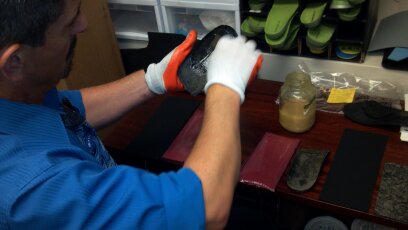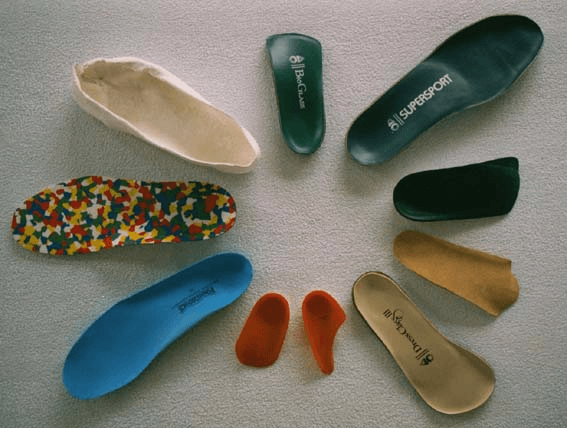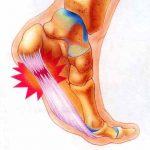Recently a patient came to my office with complaints of severe foot and arch pain. She has been experiencing this pain for over four months and it was now preventing her from walking with her friends. Walking with friends was a social and exercise activity she did 3 to 4 days a week. This was her way to relieve stress and spend time with her friends. She went to multiple doctors for this issue. The first doctor she went to was her primary care physician. The PCP did a five-minute examination without even touching her foot and told her that she had strained the foot and proceeded to prescribe her 800 mg of Motrin. He also told her to stop walking and the foot may heal on its own.
After one month of not doing anything she went back to the doctor and told him her foot was no better than when she had initially came in. The doctor then sent her to physical therapy. After waiting almost 3 weeks to get a physical therapy appointment she proceeded to undergo physical therapy for four additional weeks. During physical therapy they showed her strengthening and stretching exercises and worked on her core. She thought this was strange since she had a foot problem. After every visit they would ice the foot for 10-15 minutes. She felt like sometimes this would make her foot feel worse and cause a lot of stiffness.
With over four weeks of physical therapy under her belt and still no improvement she decided to seek out a podiatrist. She assumed a foot specialist would definitely know what was going on. At this point she was very frustrated, not being able to walk and was gaining weight more and more rapidly. Slight depression started to set in. This is something we often see with runners and athletes when they are unable to train or workout.
After finding a podiatrist within her insurance network she scheduled an appointment immediately. At her visit the podiatrist did a quick five-minute examination and said that he could fix her foot but she would need custom orthotics. At this point she became frustrated. She was willing to do whatever it took to get this problem fixed. She decided to pay the $800 and get custom orthotics from the doctor hoping this would be the miracle cure. Without taking any measurements of her foot the doctor had her step into a foam box and took molds of her feet. He then told her that her orthotics would be done in two weeks. She found it odd that he still had not really taken the time to examine the foot.
Two weeks later she got a call from the office and went back in to pick up her new custom orthotics. When she first tried them out they were hard and uncomfortable. The podiatrist told her to try them out and little by little she would get used to them. Not knowing much about orthotics she listened and tried to use these so-called “custom orthotics”. After weeks of using them and still no improvement in her foot she decided to go back to the podiatrist and let him know she was still an enormous amount of pain. He proceeded to tell her that the next course of action would be a Cortisone shot. At first she was apprehensive since she hated the idea of sticking a large needle into her foot but since nothing else was helping she was willing to give it a try. She described this injection as being “the worse pain she had every felt before”.
Once the injection was done, she was told, “that after about 2 to 3 days her foot would feel a lot better and should be pain free”. She waited and waited but her foot got worse. At this point she was at her wits end, feeling more depressed and still continuing to gain weight due to the lack of exercise. One Sunday she was at a friend’s house watching football and her friend noticed that she was limping and asked what was wrong. She explained to her that she has had this foot issue going on for many months now and it was getting worse. She was worried she might need surgery at some point. Her friend who had been a patient at the San Diego Running Institute told her to come see us. She explained that the doctor at SDRI could properly diagnosis and explain the best course of treatment. She had just spent thousands of dollars trying to fix her foot and could not get any relief from other doctors and their treatment methods so she agreed.
The next day she called and made an appointment. When she came in for her visit I did a thorough orthopedic and biomechanical examination on the foot in question. After taking a detailed history and performing an exam on the foot I knew she had Plantar Fasciitis. I explained to her what she had, why she probably had it and how we were going to fix it. She then expressed to me how no one had ever even touched her foot when examining it at the other doctor’s offices. This is a story I hear every day, sometimes twice a day from other patients.
As we talked and she asked further questions, I continued to answer them. In my head I was thinking –how very odd it was that she had been to three different places and no one had even bothered to palpate the foot. How could you know what was wrong without even pressing to find the injured area or touching her foot?
After explaining Plantar Fasciitis, I came up with a course of treatment which included therapeutic ultrasound, GuaSha / myofascial release of the foot / arch, foot manipulation and taping techniques. All of these help to increase blood flow to the injured area and decrease scar tissue build up. I also showed her various stretches that could be used to help elongate the planter fascia and reduce pain. Doing these home stretches helps to aid in the recovery process of this type of injury and speed up the tissue healing. Finally, we had to address these “Expensive Custom Orthotics” that were hard. uncomfortable and did not help. She was attached to them since she spent over $800.00. As I examined the orthotics I noticed that they were stiff, rigid and there were no real modifications made to them at the initial fitting. They were simply just molds of her feet. These orthotics were no different than orthotics you could buy over-the-counte. Since our office has an orthotic lab within, I was able to save her some money by taking her existing orthotics and modifying them to help alter the biomechanics of her foot and unload the arch of the foot. I did this by grinding the orthotic to make it ore flexible, adding padding under the arch area to make it supportive but soft and then added a full length neoprene cushion topcover cut to the exact shape of her walking shoe. this resulted in making the hard orthtoic more flexible and immediately more comfortable. You can learn everything you ever wanted to know about custom orthotics by clicking this link.

Repairing your existing orthotics
We continued to treat her foot two times a week for the next three weeks. On her last appointment, I re-examined the foot and she told me that her foot was almost pain-free (about 90% better). For the past two weeks she had been walking 6 miles a day three times a week. She was so happy that she could walk again without pain. She started referring all her friends and family to our office. One of the best complements a doctor can get from a patient is when they refer their loved ones to our office. This is when you know you have really helped someone.
Sometimes injuries can sideline a person and negatively affect their emotional well being. This was one of those cases. Many patients that come to my office come because we are the last resort. They have been to various different offices and doctors and no one can fix them. At our office we take the time to listen to the patient, give a thorough exam and get the right diagnosis. We develop a customized treatment plan for the individual and their activity or event that they are competing in. This is the key to getting them back quickly and effectively to exercising and training.
If you have foot, heel or arch pain and want more information email info@sdri.net or call to schedule an appointment 858-268-8525
Click here for more information on Plantar Fasciitis
The medical information on this site is provided as an information resource only, and is not to be used or relied on for any diagnostic or treatment purposes. This information is not intended to be patient education, does not create any patient-physician relationship, and should not be used as a substitute for professional diagnosis and treatment.



Leave A Comment